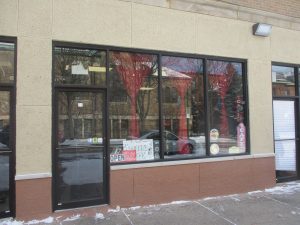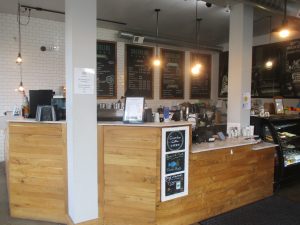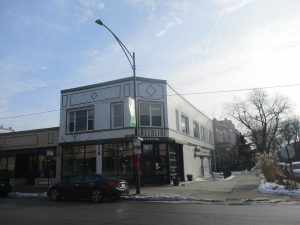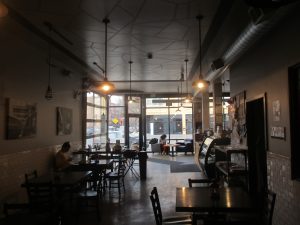South Side Coffee Shops Look to Do Good in Their Communities
By Igor Studenkov For Chronicle Media — January 23, 2018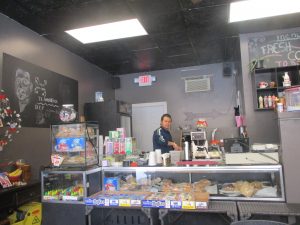
Dulce’s Cafe owner Carlos Nepomuceno stands behind the counter of his coffee shop. (Photo by Igor Studenkov/for Chronicle Media)
When Carlos Nepomuceno, of South Chicago neighborhood, opened Dulce’s Cafe, he wanted to bring a “North Side type” coffee shop to his neighborhood. And he isn’t the only one.
Over the past few years, a number of independent shops that offer coffee, pastries, food and free Wi-Fi, opened on the South Side of Chicago. While those kinds of coffee shops are dime a dozen on much of Chicago’s North and Northwest sides, they are more of a novelty in lower-income minority communities south of Roosevelt Road.
Although details differ, what unites many of them is a sense of purpose. Some were founded by nonprofits, and even many of those that weren’t didn’t start purely for business reasons. Its owners wanted to create places where residents could gather and relax. One way or another, they hope to have a positive impact on the communities they are part of.
While There are fewer coffee shops in Chicago south of Roosevelt Road than north of it, it isn’t as if the South Side doesn’t have any coffee shops at all. Starbucks has locations in Beverly, Bronzeville, Hyde Park, Chatham and South Shore.
In the fall 2016, the chain opened a location in Englewood, a low-income, majority-black neighborhood, on a shopping plaza that developed around Whole Foods’ first South Side location. A year later, it opened a location in Chinatown, on the first floor of Jaslin Hotel.
South Side also has many independent coffee shops, but most of them are located in Bridgeport and Hyde Park.
Over the past 10 years, a number of coffee shops opened in neighborhoods that previously had no coffee shops at all. In most cases, they were working class and poor neighborhoods where the majority of residents weren’t white, along commercial corridors that haven’t seen much economic and infrastructure investment.
For much of its history, South Chicago was a working-class neighborhood whose economy centered on U.S. Steel’s Southworks steel mill factories further south. As steel production slowed, so did the neighborhood economy. And when the mill closed for good in 1992, its economy was dealt a blow it was yet to recover with.
A native of Mexico City, Nepomuceno has been living in Chicago for the past 14 years. While he has been working in restaurants and coffee shops for most of his life, it wasn’t what gave him an idea to open a coffee shop.
“I used to lead a youth group in [the Immaculate Conception Catholic Church],” Nepomuceno said. “In this neighborhood, there is a lot of violence, a lot of gangs. It’s dangerous, this neighborhood, and there’s no safe place where teenagers can spend their time.”
What he saw on the North Side gave him an idea.
“North side of the loop has a lot of coffee shops where students, people from different [backgrounds] use computers,” Nepomuceno said. “That’s what I want to bring to this neighborhood.”
He wound up opening a coffee shop at 2958 W. 88th Street, across the street from the church and less than a block from Commercial Avenue, which has traditionally been one of South Chicago’s primary commercial corridors. While creating a safe place for youth was a main goal, Nepomuceno explained, he also hoped to do his part to help revitalize it.
“This neighborhood, it’s a poor neighborhood,” Nepomuceno said. “They are used to cheap stuff … stores that are really cheap. I want to turn it into a [nicer-looking] store where you can enjoy a coke or hamburger.”
He emphasized that he didn’t want higher-end stores — just something that looked better and offered more.
“Nothing has to be expensive — it just has to be pretty,” Nepomuceno said. “We don’t want drugs, we don’t want gangs, we don’t want homelessness. If you change the community for the better, all those people — at least, they’re going to want to change. Because everybody wants to live a good life.”
He named his coffee shop after his daughter, Dulce, for a reason. To him, it all comes down to doing what’s best for his family, and other families like his.
“I want to live better, because I have kids,” Nepomuceno said. “They have to live in a good neighborhood, a safe neighborhood for the next generation.”
Dulce’s isn’t the only South Side coffee shop that owes its existence to a church.
Woodlawn neighborhood is located further north, immediately south of Hyde Park. Its main commercial corridor, 63rd Street, used to be one of the city’s major commercial corridors. At its peak, it rivaled the Magnificent Mile. But only a few businesses survived since then, and other commercial areas didn’t fare much better.
Sunshine Gospel Ministries was founded in 1905, but it was actually located on the Near North Side, relocating to Woodlawn in 2001. It set up shop at 500. E. 61st Street and bought up several surrounding buildings, including 501 E. 61st Street building across the street, which would eventually become Green Line Coffee.
Ashley James has been with the coffee shop since it opened in 2015, working her way up to manager. As she explained to the Chronicle, the concept behind the shop was simple.
“They wanted to bring the community together and create jobs,” she said. “And, of course, having a great cup [of coffee] in your own community is always good.”
Contrary to what the name would suggest, the shop isn’t located next to the Green Line. But it is only a few blocks away from the spot where line’s Cottage Grove branch curves toward 63rd Street. And, as James noted, the line’s King Drive ‘L’ station is only a block north and three blocks south.
Green Line Coffee isn’t the only South Side coffee shop to be operated by a nonprofit. In June 2014, Rebuild Foundation, a Grand Crossing based art-driven community development organization, opened the Currency Exchange Cafe in Washington Park neighborhood at 305 E. Garfield Blvd., across the street from Garfield Green Line ‘L” station. And Kusaniya Cafe, which opened in November 2013 in Englewood, at 825 W. 69th St, was set up as a nonprofit from the get-go.
Back of the Yards Coffeehouse and Roastery, which is located in the eponymous neighborhood at 2059 W. 47th St., is not a nonprofit, but a portion of the profits it makes goes into its Social Impact Fund — which, according to its website, “benefits local initiatives with high social returns in Chicago’s Back of the Yards neighborhood.”
The Chronicle reached out to Currency Exchange Cafe, Kusanya and Back of the Yards Coffeehouse and Roastery, but there was no response by press time.
Build Coffee is a more unusual case. While the coffee shop isn’t a nonprofit, it rents space inside the building owned by Experimental Station— a community development nonprofit located at Woodlawn’s northern border, at 6000 S. Blackstone Ave. Co-owners Bea Malsky and Hannah Nyhar worked for “South Side Weekly,” a community newspaper that is currently based in the building, while they were students at University of Chicago. As Nyhar explained to the Chronicle, they felt that Experimental Station could use a casual space where people could gather and collaborate.
Build is among South Side’s newest coffee shops — it opened on June 24, 2017. As Nyhar explained, she had experience working as a barista, while Malsky had experience with small press book publishing — and Build reflects it. In addition to selling food and beverage, it sells books and zines.
“The coffee shops I’m most excited about are multi-use spaces that are able to pull in lots of different people,” Nyhar reflected. “The books and zines mean a bunch of writers and artists are part of the shop by stocking with us, and [their work is] another reason for people to walk in the door. I also think having things out for browsing tells people that this is a space they can linger without side-eye.”
She explained that Malsky decides which books and zines they will stock.
Both Nyhar and James told the Chronicle that the major challenge was figuring out some day-to-day aspects of running a coffee shop.
Nepomuceno said that, to him, the biggest challenge was getting local residents to try what he was offering.
He said Hispanics and African-Americans “don’t just get coffee. It’s hard to turn people. It’s a different culture.”
James said that while employee turnover proved to be an unexpected issue, Green Line Coffee has been able to accomplish what it set out to do — provide jobs for local residents.
“We have one employee who stays across the street [from Green Line Coffee],” she said. “Everybody stays within walking distance. We’re all from the community.”
And Nepomuceno said that he has been able to attract customers — even if they were not the kind of customers he was originally hoping to get.
“I see more older people come and buy a cup of coffee,” he said. “teenagers are so busy, they don’t come here.”
Nepomuceno clarified that he does get some teen customers — just not as many as he’d like.
Nyhar said that Build also got some unexpected customers.
“The biggest surprise customer-wise has been that we have a big crew of very small regulars from the elementary school next door,” she said. “We’d expected parents and teachers, and instead we have a couple dozen eight to thirteen-year-olds in first thing every morning, getting cinnamon rolls and hot chocolate, or just hanging out and staying warm. It’s a really good way to wake up, but I’ve had to cut two kids off on instructions from their mothers.”
Indeed, the fact that Build Coffee entrance faces a street sandwiched between the Experimental Station building and the Metra Electric line embankment hasn’t kept the customers from finding it.
“I think people notice the care we’ve taken with the space,” Nyhar said. “We have had so many regulars embrace us so swiftly. We have people who came in the first week and haven’t really taken a day off since. On busy days, I think the room really feels how we’d imagined it.”
James said that the community response to Green Line Coffee has been “awesome.”
“Some people [are] coming here just to check it out,” she said. “People love this little place, this little gem on the corner of 61st Street.”
One common trend along the coffee shops is that most customers are locals — even customers from outside the community tend to come from the nearby neighborhoods. James said that Green Line Coffee benefited from being located along CTA Route 59, which connects 61st Street to Red Line’s Garfield ‘L’ station, 59th Street-University of Chicago Metra Electric station and the Midway Airport.
“People come [while] waiting on the bus stop,” she said. “They come in and get a cup of coffee or a quick pastry.”
Many South Side coffee shops — including Currency Exchange, Kusanya and Build — hold regular events. Nepomuceno said that he occasionally held some, and James said that while Green Line Coffee had events in the past, it no longer does, because the coffee shop isn’t open as late as it used to, which caused it to reduce staff, which, in turn, affected its abilities to run events.
“Holding events — there’s lots of liability,” James added. “So right now, we decided to take a break from holding events.”
That said, the coffee shop offers something unique — an “open piano” that anyone can play.
“We have a guy that comes in from the community, and he comes in and plays piano a lot,” James said.
Many South Side coffee shops offer resources for the community. According to its website, Kusanya provides job training and apprenticeship opportunities. Green Line Coffee has a meeting room — complete with a whiteboard and a projector – that local residents can rent. James said it is regularly used by book clubs and condo associations. And Build makes a point to help local organizations

Build Coffee is located on the east side of the Experimental Station building. (Photo by Igor Studenkov/for Chronicle Media)
“We’ve worked with small grassroots [organizations] like Sista Afya and For the People collective to offer our space for their fundraising and organizing efforts,” Nyhar said. “Day to day, I think the single biggest thing is actively making sure everybody feels welcome in our space, full stop.”
Not every South Side coffee shop that opened over the last 10 years was able to stay in business. Flecks Coffee opened in Chatham on July 20, 2013 — only to close in November of the following year.
There hasn’t been any coffee shop that replaced it. The same fate befell Washington Heights’ A Little Something Hot and Pretty Donkey Coffee, which had locations in Jeffrey Manor and South Loop neighborhoods.
Nepomuceno told the Chronicle that he works for Uber Eats out of simple necessity — the money he earns from Dulce’s Cafe simply isn’t enough to cover his business and day-to-day expenses. But he is determined to see his vision through — at least for a few years.
“I’ll wait until [the teens] decide to come, because that was my vision, that was my objective,” he said. “My dream is — when teenagers go to college, see [coffee shops] and come back here, and ask me for a cup of coffee like they [had] in school.”
In the meantime, Nepomuceno is trying to reach more local teens by advertising on Facebook, Snapchat and Instagram — since, he said, the best way to reach them is through social networks they use.
James said that outreach will be a major priority for Green Line Coffee this year.
“A lot of people here are repeat customers, which is good, but we also want new customers,” she said. “We’re kind of strategizing to see how we can do more marketing.”
James said that she was happy with the impact the coffee shop made so far.
“Before we opened, I didn’t believe we could have a place where [people] could gather,” she said. “I think it gives people a sense of being in a safe place.”
That said, both James and Nyhar are aware that change coffee shops could inspire may not necessarily be positive. They can help attract development, but development could also lead to displacement. This is a particularly sensitive issue in Woodlawn. The University of Chicago, which didn’t venture too far beyond Hyde Park for much of the 20th century, has been expanding south — to mixed reactions.
James told the Chronicle that it was a tough issue, one that she struggled with.
“I really hope that it’s something that, as a community, as Green line, we can bridge,” she said.
Nyhart said that she and Malsky are very conscious of the fact that “coffee shops can be a buzzword for gentrification.”
“When I think about the kind of presence a coffee shop can be on a block I think about shops like [Bridgeport’s] Jackalope and [Pilsen’s] Jumping Bean; spaces that feel like a cross section of the neighborhood,” she reflected. “It’s a little bit of a tightrope, trying to offer really great coffee and food at accessible prices with a margin that can sustain us, but worrying about that and responding to our community and reworking what we offer is part of our job. The kind of development I’m interested in is seeing the nonprofit projects around us grow and thrive, drawing more of our neighbors into that work, and creating a vibrant room that’s a source of community and fuel and comfort, now and next year and the years after that.”
—- South Side Coffee Shops Look to Do Good in Their Communities —–



